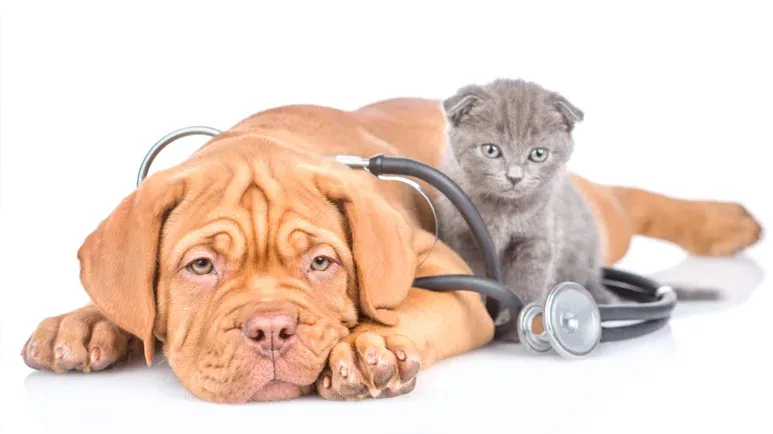Please Don't Wait for This First Symptom to Digress Into Full-Blown Heart Failure
There's a whole lot you can do to treat this first symptom. While it doesn't cure it, you can significantly halt the progression of the disease, as well as make your pet far more comfortable.

STORY AT-A-GLANCE
- The mitral valve on the left side of your pet’s heart can be defective at birth or wear out over time, such that it no longer snaps closed to form a tight seal, which allows blood to flow backward as the heart pumps
- In symptomatic pets there is usually a low-grade heart murmur in the early stages of the disease. Other signs develop over time and can include a reluctance to exercise, difficulty breathing and coughing or gagging
- The traditional treatment of mitral valve disease is to wait till the pet is symptomatic, and then prescribe one or more drugs depending on the type and severity of the disease. This isn’t a good approach, since by the time symptoms are apparent, most pets have a diminished quality of life
- A better approach is to proactively begin supplementing with a high dose of ubiquinol as soon as your pet is diagnosed, which can dramatically slow the progression of the disease
- Also critically important for dog and cat heart patients is a balanced, species-appropriate, unprocessed meat-based diet that provides all the essential amino acids necessary for heart muscle function
Editor's Note: This article is a reprint. It was originally published July 31, 2016.
The heart has four chambers. The two upper chambers are called the atria and the two lower chambers are the ventricles. The heart also has a right and left side.
Blood from the body flows into the right atrium, where it's stored briefly and then pumped into the right ventricle. The right ventricle pumps blood into the lungs where it's oxygenated then flows from the lungs back into the left atrium, where it's stored temporarily before traveling into the left ventricle.
The left ventricle contains the largest and strongest heart muscle, which is needed to pump blood throughout the body. Both the right and left sides of the heart have valves that prevent the blood from flowing backward from the lower chambers to the upper chambers.
The valves between the chambers form a tight seal that keeps blood flowing in a forward direction. The valve on the left side of the heart is the mitral valve, and the valve on the right side of the heart is the tricuspid valve.
How Mitral Valve Disease Develops
Because of the significant pressure caused by the very strong contractions of the left ventricle, whose job it is to pump blood throughout the body, the mitral valve between the upper and lower chambers on the left side of the heart can wear out over time.
The degeneration causes the valve to grow thick and deformed, so that it no longer snaps closed to form a tight seal (which is the "lub-dub" sound your veterinarian hears when listening to your pet's heart), allowing blood to flow backward as the heart pumps.
This means the heart has to work harder to pump the volume of blood the body needs for normal functions. As the heart muscle works harder, it grows in size, which makes the valve situation worse because the valves can't enlarge to accommodate the size of the heart muscle.
Another problem that can develop with heart valves is stenosis, which is a narrowing of the valve that prevents it from opening completely.
Causes of Mitral Valve Disease and Pets at Highest Risk
Mitral valve disease is more common in dogs than cats, and is often seen in small breeds like the Cavalier King Charles Spaniel, Dachshund, Toy Poodle, and Chihuahua.
Rarely, infections and surgeries have been known to cause valve degeneration. Mitral valve stenosis (narrowing of the mitral valve) can be genetic, especially in Newfoundlands and Bull Terriers, as well as Siamese cats.
Other causes include bacterial infections of the heart, cancer of the heart, and in cats, thyroid tumors can be a secondary indirect cause. Degenerative disease of the mitral valve is responsible for 75% of all heart disease in dogs. It's also called endocardiosis, chronic valvular disease, and chronic valvular fibrosis.
Symptoms of Mitral Valve Disease
Pets with early or mild mitral valve disease often have a heart murmur that a veterinarian can auscultate (hear with a stethoscope). Heart murmurs range on a scale of Grade 1 (mild) to Grade 6 (severe).
Early in the disease there might be no audible murmur, however, a Grade 1 murmur can be heard during auscultation. It's a low-severity murmur that usually involves the left side of the heart. Typically no other signs of heart disease are present at this stage.
As the condition progresses, symptoms become more apparent, including reluctance to exercise, difficulty breathing, coughing or gagging, and pale or bluish colored skin or gums.
As the disease worsens, signs of heart failure can appear, including a reluctance to lie down. This is because lying down applies pressure to the chest, which makes it harder to breathe. Pets with heart failure are often unable to rest comfortably.
Other signs can include a progressively worsening cough, reduced activity level, and loss of appetite. There can also be a buildup of fluid in the abdomen, or episodes of sudden weakness or fainting.
Diagnosing Mitral Valve Disease
Several diagnostic tests are typically performed when mitral valve disease is suspected. Your veterinarian will listen to your pet's heart with a stethoscope to identify the location and intensity of the murmur. The stethoscope also allows the vet to hear lung sounds, including fluid accumulation.
Blood and urine tests will be performed to check for other issues that may be related or have significance to the function of your pet's heart (e.g., an infection). Chest X-rays allow your veterinarian to examine the lungs and the size and shape of the heart in one dimension.
An electrocardiogram (ECG) will be performed to assess the electrical activity of the heart, measure heart rate and rhythm, and detect and evaluate arrhythmias (abnormal heart rhythms).
An ultrasound of the heart (called an echocardiogram) is a very important diagnostic tool that helps your veterinarian visualize the four chambers of the heart, as well as the valves, in three dimensions (as opposed to a one-dimensional X-ray). It also allows for evaluation of the contractions of the heart and performance of the valves. Occasionally, veterinary cardiologists perform additional advanced tests to assist in determining the extent of the heart disease.
Traditional Treatment of Mitral Valve Disease
If there is an underlying curable cause for your pet's mitral valve disorder, such as an infection, the problem with the heart valve can often also be remedied.
The traditional treatment for symptomatic pets includes several drugs, depending on the type and severity of the disease. These drugs can include diuretics to remove excess fluid from the body, enzyme blockers, vasodilators to open arteries and veins to improve blood flow, digitalis glycosides, and nitroglycerin. While heart valves can often be surgically replaced in humans, this is not the case with pets, unfortunately.
The goal of treatment for irreversible mitral valve disease is to slow its progression and alleviate symptoms so your pet can live comfortably with a good quality of life for as long as possible. This is why you must partner with a proactive veterinarian the minute your pet is diagnosed with mitral valve disease.
A Proactive Approach Using High Doses of Ubiquinol
Conventional veterinarians often suggest doing nothing about the congenital (from birth) form of mitral valve disease until symptoms appear. However, if you wait until heart disease causes notable symptoms, usually by that point quality of life is diminished.
Waiting until mitral valve disease evolves into congestive heart failure is a reactive rather than proactive approach. As soon as a pet is diagnosed with valve disease, you must do two very important things.
First, put your pet on ubiquinol. Providing the reduced form of CoQ10 can improve myocardial cellular respiration, thereby reducing cardiovascular stress, which is extremely important. It's the most important supplement you can provide to a pet with valve disease.
Research shows that humans with heart disease do exceptionally well taking very high doses of this supplement. It's also one of the best defenses you can employ immediately following your pet's diagnosis.
Also Critically Important — A Species-Appropriate, Meat-Based Diet
The second thing you must to do is remove all the fillers from your pet's diet, because they offset his critical amino acid intake. Dogs and cats are carnivores and require amino acids from animal meat to maintain healthy muscle function, including heart muscle function.
Commercial dry and canned foods contain fillers or starch in the form of potatoes, rice, whole wheat, lentils, peas, tapioca, etc. These are unnecessary carbohydrates pet food manufacturers use in place of the meat protein that is so critical to the health of dogs and cats.
Processed foods are also manufactured at very high heats, which denatures meat protein and substantially alters the bioavailability of amino acids. Ultimately, pets on processed food diets are amino acid deficient, which can have a negative effect on heart health.
The mitral valve disease that progresses fastest is in cats and dogs fed vegetarian diets. Some pet parents, often in consultation with their traditional veterinarian, put their dog or cat on a vegan or vegetarian diet, often to address food sensitivities.
These poor animals wind up with concurrent heart problems, and the progression of the disease is profound compared to patients fed a species-appropriate diet. Pets with mitral valve disease can live a long, happy life if they're eating a nutritionally balanced, fresh meat-based diet.
If your cat or dog is eating processed pet food and you can't or don't want to transition to a species-appropriate homemade diet, or alternatively, to a commercially available raw meat-based diet, then supplement with the amino acids missing from commercial diets, including L-carnitine, taurine, carnosine, and arginine.











